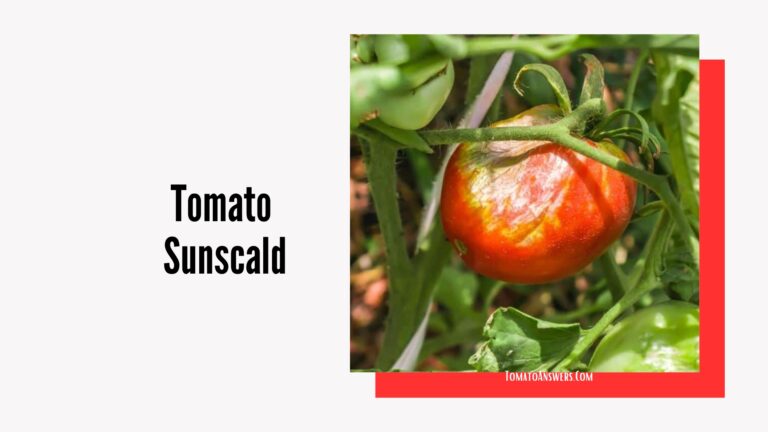In This Article
Key Takeaways:
- Tomato sunscald is a common problem that can significantly reduce the yield and quality of tomato plants.
- Proper tomato plant care is crucial in preventing sunscald, and gardeners can implement key preventive measures like providing shade, mulching, and selecting resistant tomato varieties.
- The signs of sunscald include yellow or white patches on the fruit and recessed areas with dried, papery skin, while the causes can range from intense sunlight exposure to poor air circulation.
- Various remedies and solutions like removing affected fruits, providing temporary shade, and using protective covers can help treat sunscreens and minimize further damage.
Tomato Sunscald: Prevent, Identify & Treat This Common Problem
As a professional copywriting journalist, I have seen the devastating effects of tomato sunscald on countless home gardens and farms. This common problem can drastically reduce the yield and quality of tomato plants, making it essential for gardeners to understand how to prevent, identify, and treat sunscald.
In this article, I will equip you with the knowledge and tools you need to protect your tomato plants from sunscald. I will discuss the importance of proper tomato plant care, including key preventive measures, signs of sunscald, causes, and various treatment options.
Tomato Sunscald: What is it and How to Prevent it?
Tomato sunscald is a common issue that occurs when the fruit is exposed to intense sunlight, resulting in discoloration, dry patches, and papery skin. Sunscald can occur on any part of the tomato, but it is most commonly found on the side exposed to the sun.
Prevention is key when it comes to tomato sunscald. Proper care and attention to your tomato plants can go a long way in preventing sunscald.
One effective way of avoiding sunscald is by providing sufficient shade with the help of shade cloth or other methods, such as planting sunflowers around your tomatoes to create a natural shade.
Mulching also helps to prevent sunscald by keeping the soil moist and preventing it from overheating. Another approach is to select tomato varieties that are more resistant to sunscald and better suited for your region.
It’s important to note that good tomato plant care helps to prevent a variety of other problems as well. Proper watering, adequate fertilization, and sufficient ventilation all contribute to healthier tomato plants and less susceptibility to sunscald.
So make sure you take care of your tomato plants regularly, and they will reward you with juicy, sunscreen-free fruits.
Identifying Tomato Sunscald: Signs and Causes
One of the first steps in preventing tomato sunscald is recognizing the signs. The most noticeable symptom of sunscald is a yellow or white patch on the fruit. In severe cases, the patch becomes sunken with papery skin.
Tomato sunscald occurs when the fruit is exposed to intense sunlight for an extended period. This usually happens when the foliage is damaged or not dense enough to provide adequate shade.
The lack of foliage can result from pruning, diseases, or pests. Additionally, poor air circulation can trap heat around the fruit, exacerbating sunscald conditions.
It’s important to keep in mind that sunscald can also occur during transportation or storage due to exposure to sunlight. Therefore, it’s crucial to handle tomatoes carefully and store them in a cool and dark place.
Remember that early detection and action can prevent further sunscald damage to your tomato plants.
Treating Tomato Sunscald: Remedies and Solutions
If you notice sunscald on your tomato plants, it’s essential to take prompt action to minimize the damage. Here are some remedies and solutions you can try:
| Remedy/Solution | Description |
|---|---|
| Remove affected fruits | Once you notice sunscald, remove any affected fruits immediately to prevent them from rotting and attracting insects. |
| Provide temporary shade | Use shade cloth, cardboard, or anything else that will provide enough shade for your plants without blocking too much sunlight. Use stakes to keep the shade cover in place. |
| Use protective covers | Protective covers like row covers, plastic cloches, or cold frames can help protect your plants from intense sunlight or other environmental stresses. Make sure to remove them once the risk of sunscald has passed. |
| Apply sunscreen sprays | You can apply sunscreen sprays to the fruits to protect them from sunburn. Sunscreen sprays are available at garden centers and online. |
| Use reflective mulch | Reflective mulch can help keep the soil cool and prevent the sun from reflecting onto your plants. Silver or aluminum foil can also be used as reflective mulch. |
Remember, prevention is always better than cure when it comes to sunscald. Ensure that your tomato plants are healthy and that you provide enough shade and adequate foliage to prevent sunscald from occurring. By using these remedies and solutions, you can minimize the impact of sunscald and protect your tomato plants from further damage.
Conclusion: Tomato Sunscald
Tomato sunscald is a common problem that can significantly impact the health and yield of your tomato plants.
As a professional copywriting journalist, I recommend taking proactive steps to prevent and identify sunscald in your garden. This includes ensuring proper tomato plant care, such as providing sufficient shade and mulching and selecting appropriate tomato varieties that are more resistant to sunscald.
If you do notice signs of sunscald, such as yellow or white patches on the fruit or recessed areas with dry, papery skin, it is crucial to take prompt action.
This may involve removing affected fruits, providing temporary shade, or using protective covers. Natural remedies like sunscreen sprays or reflective mulch can also be effective in minimizing sunscald damage.
FAQ about Tomato Sunscald
Q: What is tomato sunscald?
Tomato sunscald is a common problem in tomato plants where the fruit becomes damaged due to exposure to intense sunlight. It typically appears as yellow or white patches on the fruit with dried, papery skin and can lead to the development of hollow areas.
Q: How can I prevent tomato sunscald?
To prevent tomato sunscald, it is important to provide sufficient shade for the plants. This can be done by using shade cloth or planting taller crops nearby to provide natural shade.
Mulching around the base of the plants can also help regulate soil temperature and reduce the risk of sunscald.
Additionally, selecting tomato varieties that are more resistant to sunscald can be beneficial.
Q: What are the signs and causes of tomato sunscald?
Signs of tomato sunscald include yellow or white patches on the fruit with dried, papery skin. The causes of sunscald can include intense sunlight exposure, lack of foliage to provide shade and poor air circulation around the plants.
Q: How can I treat tomato sunscald?
If tomato sunscald is detected, it is important to remove the affected fruits promptly. Providing temporary shade for the plants, such as using umbrellas or row covers, can help protect them from further sun damage.
Applying sunscreen sprays or using reflective mulch can also provide some protection.
It is crucial to take action as soon as the first signs of sunscald appear to minimize the impact and prevent additional damage.

